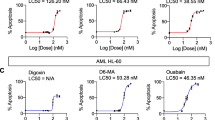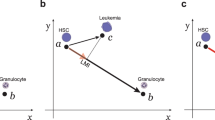Summary
HMBA is a potent differentiating agent capable of causing>95% morphological differentiation in cell lines in vitro. The induction of differentiation is dependent on both the concentration of and the duration of exposure to HMBA. However, acute toxicities (neurotoxicity and acidosis) have limited the maximal HMBAc ss value to <2mm, which is at the lower limit of effective in vitro concentrations. When HMBAc ss values have been maintained at 1–2mm, thrombocytopenia has limited the duration of HMBA infusion to ≤10 days. The present studies were performed to determine whether exposure to HMBA could be individualized and maximized without resulting in intolerable toxicity to patients and to determine which factors would predispose a patient to the development of acute toxicity during treatment with HMBA. For these investigations, patients were given HMBA at a targetc ss using an adaptive-feedback-control method rather than at a set dose. Because HMBA administration produces large anion gaps, a simple maneuver such as alkalinization might enable the escalation of plasma HMBAc ss values to >2mm. HMBA was given as a 5-day CI to 14 patients (26 courses) at 2 target HMBAc ss levels near the maximal tolerated value in the presence or absence of concurrent alkalinization with sodium bicarbonate. Symptomatic acidosis occurred in one patient who did not receive bicarbonate. Neurotoxicity proved to be dose-limiting at the target HMBAc ss value of 1.5–2.0mm in the absence of concurrent alkalinization and at ac ss level of >2mm, regardless of alkalinization. No neurotoxicity was seen at target HMBAc ss values of 1.5–2.0mm in patients who did receive concurrent alkalinization. Alkalinization was not associated with any detectable changes in plasma HMBA metabolites. With the maximal tolerable 5-day HMBAc ss having thus been defined at 1.5–2.0mm, we attempted to maximize exposure to HMBA by defining a tolerable duration of infusion. Individualization of the duration of HMBA infusion to a target nadir PLT was performed in patients who had received an initial 5-day CI of HMBA at ac ss 1.5–2.0mm along with concurrent alkalinization. The AUC achieved and the thrombocytopenia produced during this first course were used to predict the duration of infusion that each patient would subsequently tolerate (at an HMBAc ss of 1–2mm) to achieve a nadir PLT of 75,000–100,000/μl. The observed percentage changes in PLT matched the predicted percentage change in PLT, with the mean error (ME) being −8.9%. For a better determination as to which factors may contribute to neurotoxicity or acidosis in patients receiving HMBA, 98 courses of HMBA given as 5- to 10-day CIs to 56 patients were analyzed (multifactorial logistic regression). An HMBA AUC value of >7.5mm x day, the use of any concomitant narcotic analgesics, and a mean plasma HMBA level of >1.5mm or a peak plasma concentration of ≥1.75mm correlated significantly with grade 3 neurotoxicity (P<0.001), whereas concomitant alkalinization and a mean plasma HMBA concentration of <1.5mm were associated with a lack of neurotoxicity (P<0.001). An AUC value of >7.5mm x day, a mean or peak plasma HMBA level of >1.5mm, and an age of >70 years correlated with the likelihood of a large anion gap (P<0.03). With the above factors being accounted for, neither the duration of infusion nor theC cr value showed any correlation with these toxicities in this patient population. These results imply that HMBA may be given for individualized durations at ac ss of 1.5mm in the presence or absence of concomitant alkalinization and that narcotic analgesics should not be given to patients receiving this agent. However, due to the resultant acute neurotoxicity, it is unlikely that AUCs of >7.5mm x day will be tolerated during simultaneous maintenance of ac ss value of >1.0mm.
Similar content being viewed by others
Abbreviations
- HMBA:
-
hexamethylene bisacetamide
- c ss :
-
plasma steadystate concentration
- CI:
-
continuous infusion
- ME:
-
mean error
- PLT:
-
platelet count
- AUC:
-
area under the concentration-time curve
- C cr :
-
creatinine clearance
- DMSO:
-
dimethylsulfoxide
- NMF:
-
N-methylformamide
- UMCC:
-
University of Maryland Cancer Center
- ECOG:
-
Eastern Cooperative Oncology Group
- WBC:
-
white-blood-cell count
- CBC:
-
complete blood count
- EKG:
-
electrocardiogram
- AG:
-
anion gap
- Vmax :
-
predicted maximal nonrenal HMBA elimination rate
- K m :
-
predicted concentration of HMBA at which the nonrenal elimination rate is half of the Vmax value
- SLOPE:
-
predicted slope relating the renal clearance of HMBA toC cr
- Ra:
-
new infusion rate
- Hct:
-
hematocrit
- 6AcHA:
-
6-acetamidohexanoic acid
- NADAH:
-
N-acetyl-1,6-diaminohexane
- DAH:
-
1,6-diaminohexane
- 6AmHA:
-
6-aminohexanoic acid
- MAO:
-
monoamine oxidase
- MAP:
-
maximum a priori
- MAE:
-
mean absolute error
References
Breitman TR, He R (1990) Combinations of retinoic acid with either sodium butyrate, dimethyl sulfoxide, or hexamethylene bisacetamide synergistically induce differentiation of the human myeloid leukemia cell line HL60. Cancer Res 50: 6268
Browne B, Linter S (1987) Monoamine oxidase inhibitors and narcotic analgesics: a critical review of the implications for treatment. Br J Psychiatry 151: 210
Callery PS, Egorin MJ, Geelhaar LA, Nayar MSB (1986) Identification of metabolites of the cell-differentiating agent hexamethylene bisacetamide in humans. Cancer Res 46: 4900
Chun H, Leyland-Jones B, Hoth D, Shoemaker D, Wolpert-DeFilippes M, Grieshaber C, Cradock J, Davigno P, Moon R, Rifkind R, Wittes RE (1986) Hexamethylene bisacetamide: a polar-planar compound entering clinical trials as a differentiating agent. Cancer Treat Rep 70: 991
Collins SJ, Bodner A, Ting R, Gallo RC (1980) Induction of morphological and functional differentiation of human promyelocytic leukemia cells (HL-60) by compounds which induce differentiation of murine leukemia cells. Int J Cancer 25: 213
Conley BA, Callery PS, Egorin MJ, Subramanyam B, Geelhaar LA, Pan S (1988) Involvement of monoamine oxidase and diamine oxidase in the metabolism of the cell differentiating agent hexamethylene bisacetamide (HMBA). Life Sci 43: 793
Conley BA, Forrest A, Egorin MJ, Zuhowski EG, Sinibaldi V, Van Echo DA (1989) Phase I trial using adaptive control dosing of hexamethylene bisacetamide (NSC 95 580). Cancer Res 49: 3436
Conley BA, Sewack GF, Egorin MJ, Subramanyam B, Page JG, Grieshaber CK (1992) Effect of the monamine oxidase inhibitor isocarboxazid on the canine metabolism of the cell-differentiating agent hexamethylene bisacetamide. Cancer Chemother Pharmacol (in press)
D'Argenio DZ, Schumitzky A (1979) A program package for simulation and parameter estimation in pharmacokinetic systems. Comp Prog Biomed 9: 115
Dempsey P, Winawer S, Friedman E (1989) Twenty day treatment of HT29 colon carcinoma cells with HMBA induces cells permanently differentiated at different stages in colonocyte differentiation, some with response to TGFb1. Proc Am Assoc Cancer Res 30: 47
Egorin MJ, Sigman LM, Van Echo DA, Forrest A, Whitacre MY, Aisner J (1987) A phase I clinical and pharmacokinetic study of hexamethylene bisacetamide (HMBA, NSC 95 580) administered as a five day continuous infusion. Cancer Res 47: 617
Egorin MJ, Zuhowski EG, Nayar MSB, Callery PS (1987) Gas chromatographic analysis of metabolites of the cell differentiating agent hexamethylene bisacetamide. J Chromatogr 415: 148
Ettinger DS, Orr DW, Rice AP, Donehower RC (1985) Phase I study ofN-methylformamide in patients with advanced cancer. Cancer Treat Rep 69: 489
Folstein MF, Folstein SE, McHugh PR (1975) “Mini-mental state”: a practical method for grading the cognitive state of patients for the clinician. J Psychiatr Res 12: 189
Forrest A, Conley BA, Egorin MJ, Zuhowski E, Sinibaldi V, Jasman NM, Van Echo DA (1988) Adaptive control of hexamethylene bisacetamide (HMBA) pharmacodynamics. Proc Am Soc Clin Oncol 7: 61
Harrell FE Jr, Lee KL, Pollock BG (1988) Regression models in clinical studies: determining relationship between predictors and response. J Natl Cancer Inst 80: 1198
Kelley JA, Roth JS, Litterst CL (1985) Gas chromatographic determination of hexamethylene bisacetamide in plasma and urine. Anal Lett 18: 1043
Litterst CL, Roth JS, Kelley JA (1985) Distribution, elimination, metabolism and bioavailability of hexamethylene bisacetamide in rats. Invest New Drugs 3: 263
Maling HM, Highman B, Spector S (1962) Neurologic, neuropathologic and neurochemical effects of prolonged administration of phenylisopropylhydrazine (JB 516), phenylisobutylhydrazine (JB835), and other monoamine oxidase inhibitors. J Pharmacol Exp Ther 137: 334
Marks PA, Sheffery M, Rifkind RA (1987) Induction of transformed cells to terminal differentiation and the modulation of gene expression. Cancer Res 47: 659
Murphy DL, Garrick NA, Aulakh CS, Cohen RM (1984) New contributions from basic science to understanding the effects of monoamine oxidase inhibiting antidepressants. J Clin Psychiatry 45: 37
O'Dwyer PJ, Donehower M, Sigman LM, Fortner CL, Aisner J, Van Echo DA (1985) Phase I trial ofN-methylformamide (NMF, NSC 3051). J Clin Oncol 3: 853
Palfrey C, Kimhi Y, Littauer UZ, Reuben RC, Marks PA (1977) Induction of differentiation in mouse neuroblastoma cells by hexamethylene bisacetamide. Biochem Biophys Res Commun 76: 937
Rabson AS, Stern R, Tralka TS, Costa J, Wilczek J (1977) Hexamethylene bisacetamide induces morphologic changes and increased synthesis of procollagen in cell line from glioblastoma multiforme. Proc Natl Acad Sci USA 74: 5060
Reuben RC (1979) Studies on the mechanism of action of hexamethylene bisacetamide, a potent inducer of erythroleukemic differentiation. Biochim Biophys Acta 588: 310
Reuben RC, Wife RL, Breslow R, Rifkind RA, Marks PA (1976) A new group of potent inducers of differentiation in murine virus-infected erythroleukemia cells. Proc Natl Acad Sci USA 73: 862
Rowinsky EK, Ettinger DS, Grochow LS, Brundrett RB, Cates AE, Donehower RC (1986) Phase I and pharmacologic study of hexamethylene bisacetamide in patients with advanced cancer. J Clin Oncol 4: 1835
Rowinsky EK, Ettinger DS, McGuire WP, Noe DA, Grochow LB, Donehower RC (1987) Prolonged infusion of hexamethylene bisacetamide: a phase I and pharmacological study. Cancer Res 47: 5788
Schroy PC, Carnright K, Winawer SJ, Friedman EA (1988) Heterogeneous responses of human colon carcinomas to hexamethylene bisacetamide. Cancer Res 48: 5487
Sheiner LB, Beal SL (1982) Bayesian individualization of pharmacokinetics. Simple implementation and comparison with non-Bayesian methods. J Pharm Sci 71: 1344
Snyder SW, Egorin M, Geelhaar LA, Hamburger AW, Callery PS (1988) Induction of differentiation of human promyelocytic leukemia cells (HL60) by metabolites of hexamethylene bisacetamide. Cancer Res 48: 3613
Spremulli EN, Dexter DL (1984) Polar solvents: a novel class of antineoplastic agents. J Clin Oncol 2: 227
Van Roozendaal KEP, Darling D, Farzaneh F (1990) DMSO and retinoic acid induce HL-60 differentiation by different but converging pathways. Exp Cell Res 190: 137
Ward FT, Kelly JA, Roth JS, Lombardo FA, Weiss RB, Leyland-Jones B, Chun HG (1991) A phase I bioavailability and pharmacokinetic study of hexamethylene bisacetamide (NSC 95 580) administered via nasogastric tube. Cancer Res 51: 1803
Waxman S, Scher BM, Hellinger N, Scher W (1990) Combination cytotoxic-differentiation therapy of mouse erythroleukemia cells with 5-fluorouracil and hexamethylene bisacetamide. Cancer Res 50: 3878
Young CW, Fanucchi MP, Walsh TD, Baltzer L, Yaldaei S, Stevens Y, Gordon C, Tong W, Rifkind RA, Marks PA (1988) Phase I trial and clinical pharmacological evaluation of hexamethylene bisacetamide administration by ten-day continuous intravenous infusion at twenty-eight day intervals. Cancer Res 48: 7304
Zupi G, Marangolo M, Arancia G, Greco C, Laudonio N, Iosi F, Farmisano G, Malorni W (1988) Modulation of the cytotoxic effect of 5-fluorouracil byN-methylformamide on a human carcinoma cell line. Cancer Res 48: 6193
Author information
Authors and Affiliations
Additional information
Supported by contracts N-01-CM-57734 and N-01-CM-07 303 awarded by the National Cancer Institute, Department of Health and Human Services. One of the authors (B. A. C.) is the recipient of American Cancer Society Clinical Oncology Career Development Award 90-127
Rights and permissions
About this article
Cite this article
Conley, B.A., Egorin, M.J., Sinibaldi, V. et al. Approaches to optimal dosing of hexamethylene bisacetamide. Cancer Chemother. Pharmacol. 31, 37–45 (1992). https://doi.org/10.1007/BF00695992
Received:
Accepted:
Issue Date:
DOI: https://doi.org/10.1007/BF00695992




